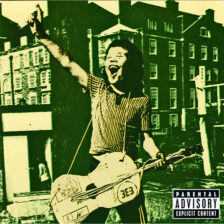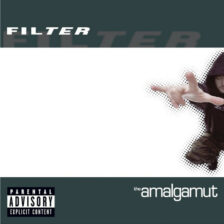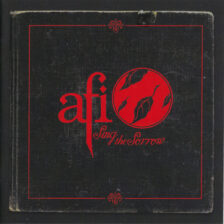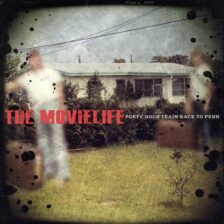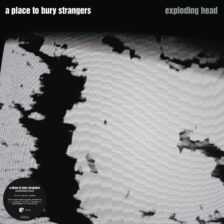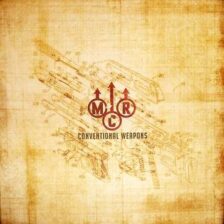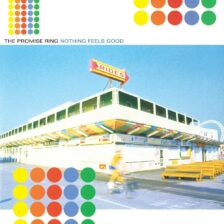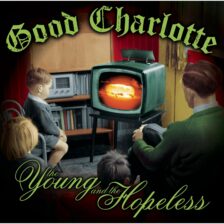Third Eye Blind found themselves at a bit of a crossroads when the time came to write the follow-up to two successful records: their stunning self-titled LP and Blue. Longtime guitarist/songwriter, Kevin Cadogan, was replaced with Tony Fredianelli and Out of the Vein would be the second album in a row without an outside producer. The band’s chemistry somehow didn’t suffer on this album that most 3EB fans rank very highly when looking back on the full breadth of the band’s discography. The album was recorded at their own Mourning Wood Studios in San Francisco, and Stephan Jenkins admitted that nearly 40 songs were written during the pre-production sessions that would become their third LP. Originally called Crystal Baller, but scrapped because everyone outside of Jenkins hated the name, Out of the Vein would solidify the band as one of the premiere acts in Alternative Rock history. The record was supposed to be released in early 2002, but the mounting pressure to live up to the legacy left behind on their first two albums led to several lyric re-writes. Ultimately, these growing pains worked out in the band’s favor creatively, even as their label (Elektra Records) imploded right as Third Eye Blind would release the record. Out of the Vein may not have the sheen of Blue, or the bulletproof legacy of their self-titled debut, but it still features several great Third Eye Blind songs that have stood the test of time.
Read More “Third Eye Blind – Out Of The Vein”Review: Fall Out Boy – Take This To Your Grave
You never forget your first love. Sure, they may leave you heartbroken and picking up the pieces of where to turn to next, but those scars cut deep. Fall Out Boy arrived on the pop-punk scene with their debut LP, called Take This To Your Grave, that featured slick hooks and sing-a-long choruses that made this band destined for superstardom. The band was technically signed to Island Records through a “first-ever incubator type of deal” that gave them money to sign a one-off record deal to put their debut out on Fueled By Ramen to grow a steady following before their major label debut. This seemed to pay off big time for both Fall Out Boy and Island Records, as the band would become one of the hottest acts around by the time From Under The Cork Tree was released. The now-iconic cover photo of the band sitting on a broken futon was actually the second choice from the label, as the initial concept of a live photo was rejected. The lyrical material is largely based around fractured relationships, falling in and out of love, and traveling, while it became a point of contention between bassist Pete Wentz and lead vocalist Patrick Stump. During the recording of the LP, Wentz and Stump argued for days on end about the direction of the lyrics, but they ultimately believe that through this conflict came something beautiful.
Read More “Fall Out Boy – Take This To Your Grave”Review: Filter – The Amalgamut
The third studio album from Alternative rockers, Filter, came with immense pressure to deliver after their first two records (Short Bus and Title of Record) both went platinum. The band was also battling with lineup changes, lead vocalist/band leader Richard Patrick’s addictions, and a record label wanting Filter to deliver the goods with another hit. The Amalgamut found moderate success due in large part to the lead single “Where Do We Go From Here,” and “The Only Way (Is The Wrong Way)” getting a prominent placement in a Hummer commercial. Recently reissued on a beautiful gatefold double LP set, and making its debut on vinyl for the first time via Craft Recordings, Filter’s third album gets its moment in the limelight.
Read More “Filter – The Amalgamut”Review: AFI – Sing the Sorrow
How exactly did AFI transition from being a band that hardcore and goth kids had in their back pocket to becoming such a pop culture worldwide phenomenon? The answer depends on who you ask. Having outgrown their indie label of Nitro Records given the monumental success of their fifth studio album, The Art of Drowning, AFI were simply destined for a wider audience on their major label debut called Sing the Sorrow. This record was produced by A-list veterans Jerry Finn (Blink-182) and Butch Vig (Nirvana), and they helped the band craft some of their strongest songs to date. Much to the surprise of many record executives, and to the delight of their Dreamworks Records label, AFI’s Sing the Sorrow would sell 96,000 copies in its first week and debut at number five on the Billboard 200. This record seemed to be an unstoppable giant that both the hardcore/goth kids could sing a long to with the same audience as newer fans who liked Blink-182 and other pop-punk bands. The lead single of “Girl’s Not Grey” was a perfect choice of introducing AFI to a wider audience, and it was filled with slick hooks, great guitar work, and Davey Havok’s trademark vocal howls. The great thing about AFI’s growing audience was that their concerts would be a combination of kids from all different backgrounds coming together with the same unified feeling towards this band’s music. This accomplishment didn’t happen overnight, and yet AFI’s trajectory had quickly launched into the stratosphere.
Read More “AFI – Sing the Sorrow”Review: The Movielife – Forty Hour Train Back To Penn
Like many people who grew up in the height of the Drive-Thru Records era, discovering new up and coming bands was a bit of a tricky science. For me personally, I found many new artists through punk rock CD compilations, surfing the web on AbsolutePunk, getting to a concert early to check out the openers, or by skimming through the pages of Alternative Press. So how did a band like The Movielife make it so easy to enjoy their music? The Movielife were a punk rock band in spirit, but their ability to mix in hardcore elements and make their concerts an experience made me a lifelong fan. Early songs like “Hand Grenade” and “Walking On Glass” were my first introduction to the band, and it made me backtrack through their earlier catalog to grab as much music as I could get my hands on.
The third full-length studio album from The Movielife felt like a momentous opportunity for them to stand out from the pack of Drive-Thru bands that began dominating the greater part of the decade. Forty Hour Train Back To Penn was recorded at Salad Days Studio with veteran producer Brian McTernan, and his fingerprints are all over this punk classic. The band released two singles from the set, “Jamestown” and “Face or Kneecaps,” however during the promotional cycle of the record, The Movielife decided to call it quits. This kind of derailed the intentions of Drive-Thru Records doing a bigger push for the LP, but the legacy that this band left behind is still felt today. The majority of the songs written on this record were by lead vocalist Vinnie Caruana and guitarist Brandon Reilly, and they would end up being the last ones standing when The Movielife released Cities in Search of a Heart 14 years later. Forty Hour Train Back To Penn tackles many situations head-on like fractured relationships, traveling on the road, and growing up, while still having an emotional element to each track to showcase the band’s collective growth as people and musicians.
Read More “The Movielife – Forty Hour Train Back To Penn”Review: Audioslave – Audioslave
When Zack de la Rocha left Rage Against the Machine the band was at a crossroads of where to turn to next. Veteran producer Rick Rubin suggested the band reach out to Chris Cornell (of Soundgarden fame) to pursue an exploration of the two powerhouse bands together as a new one. Cornell originally was planning on writing some material for a solo project, but he found the opportunity to work with the rhythm section of Rage Against the Machine too tempting to pass up. Audioslave was born as Cornell took the opportunity to sing over some song structures the band had laid out for him to sing over. Guitarist Tom Morello recalls the first jam session in detail as he said, “”He stepped to the microphone and sang the song and I couldn’t believe it. It didn’t just sound good. It didn’t sound great. It sounded transcendent. And…when there is an irreplaceable chemistry from the first moment, you can’t deny it.” This unique combination of Rage and Soundgarden would lead to a self-titled debut album that would go on to sell over 3 million units in the U.S. alone and establish this band in the forefront of Alternative Rock radio for the better part of a decade.
Read More “Audioslave – Audioslave”Review: A Place To Bury Strangers – Exploding Head
The sophomore record from A Place To Bury Strangers called Exploding Head has received a vinyl reissue with nearly a full second album’s worth of bonus tracks tacked on to the end for your enjoyment. This “noise rock” band sounds crisp and full on the vinyl version that I’m listening to, and features some extensive packaging and other treats in this 13th anniversary deluxe set. When the album was released in 2009, it garnered mostly positive reviews, and it’s easy to see why. A Place To Bury Strangers channel the deepest, darkest parts of industrial rock in a sound that fans of NIN, My Bloody Valentine, and AFI would certainly enjoy.
Read More “A Place To Bury Strangers – Exploding Head”Review: My Chemical Romance – Conventional Weapons
The circumstances that led to My Chemical Romance releasing a collection of scrapped album material, known now as Conventional Weapons, could’ve come under happier situations. However, shortly after the release of the album, that was spread out over five 7-inch records (called Number One, etc.) the band would shock their rabid fanbase and music fans alike by announcing their breakup on March 22nd, 2013. I vividly remember being cautiously excited when Conventional Weapons was first announced, because I’ve seen this formula all too well when bands suddenly release all of their previously scrapped material or extended B-sides before going their separate ways. MCR unfortunately would follow down this unfortunate path, and would not reunite until their announcement was made on October 31, 2019.
Conventional Weapons being observed as a compilation of B-sides, or scrapped material, is a bit unfair since this material flows well in the 10-song sequencing and many fans still consider this to be a “fifth” studio album from My Chemical Romance. The band has even continued to incorporate many of these songs into their setlist on their US tour, so one could argue that the band still believes strongly in these tracks as well. From the aggressive opening sequence of “Boy Division” to the closing bars of “Burn Bright,” MCR made sure their legacy was left intact on this record that has started to get more notoriety over time.
Read More “My Chemical Romance – Conventional Weapons”Review: Taylor Swift – Red
There are moments growing up that feel jarring and alien and terrifying for how wildly different they seem from everything else that came before them. Your first kiss; the first time you drive a car without anyone in the passenger’s seat; the first time you feel the buzz of alcohol; the first night in your college dorm room, knowing you’re in uncharted territory. These moments can feel like swimming off the deep end without a lifejacket for the first time, or maybe even like skydiving without a parachute. They’re exciting because of the unpredictability, because they feel dangerous. You don’t know what’s going to happen next, but you do know that you’ve just crossed some invisible line on the journey of growing up, and that you can’t turn around and go back.
On Red, Taylor Swift captured the unpredictable, stomach-dropping, dangerous rush of perhaps the most important growing up “first”: falling in love. The result was her best record, the greatest album released in the 2010s, and one of the most complete documents ever made about young love’s roller-coaster highs and crushing lows. Even good albums about love often cover only a fraction of what it’s like to go from strangers to friends to how-can-I-ever-live-without-yous and then back to strangers again. Even great albums about love might only paint with a hue or two from that expansive, explosive palette of technicolor emotion. On her fourth album, Taylor Swift painted with all the colors in love’s deep, endless rainbow – even if, at the time, she probably would have told you she was only painting with one.
Read More “Taylor Swift – Red”Review: The Promise Ring – Nothing Feels Good
The sophomore album by The Promise Ring, called Nothing Feels Good, is largely credited for its influence in starting a wave of movement in the emo genre. The record has now turned 25 years old, so I thought it would be a great idea to revisit just what made this album so damn special. The album was produced by J. Robbins, and the cover art features a shot of Trimper’s Rides in the heart of the boardwalk in Ocean City, Maryland. The album title also inspired author Andy Greenwald to use it for his great, comprehensive guide of emo music called Nothing Feels Good: Punk Rock, Teenagers, and Emo that I thoroughly enjoyed reading when it was released. What made The Promise Ring so endearing was their mix of power pop chords paired with a heart on their sleeves approach to their lyrics that led to several quotable moments within their songs. Nothing Feels Good is an endearing collection of 12 slick emo anthems that deservedly earned their time in the spotlight today.
Read More “The Promise Ring – Nothing Feels Good”Review: Dead Kennedys – Fresh Fruit For Rotting Vegetables
The legendary record, Fresh Fruit For Rotting Vegetables, by Dead Kennedys has recently been remastered by Chris Lord-Alge, and has officially been re-issued as of last Friday. Given this recent exciting news, I figured I would take a walk back through the band’s debut studio album to see how it sounds through some fresh ears. Lord-Alge shared, ““Revisiting Fresh Fruit for Rotting Vegetables was such an inside peek at a band packing so much excitement onto tape for every song. The style and playing has such drive and spirit. The big challenge for me was keeping it honest to its original sound and not letting it become modern but improving the separation and clarity. A major chapter in history for Dead Kennedys.” With such steadfast dedication to making each and every song come alive again, Dead Kennedys can look back fondly on this reissued set that packs a nice new shiny punch to it.
Read More “Dead Kennedys – Fresh Fruit For Rotting Vegetables”Review: Good Charlotte – The Young and the Hopeless
The sophomore effort from Good Charlotte was by far their most successful record, selling over 3.5 million copies in the United States alone. The Young and the Hopeless features plenty of crisp pop-punk production, courtesy of veteran hit-maker Eric Valentine, and the band spent nearly three months crafting the recordings. While many critics panned the new material, fans of pop-punk and fans of their earlier material were able to find plenty to enjoy on the album. The record rips into a introductory track called “A New Beginning” and the hard-nosed guitar parts in the instrumental song signaled a cosmic shift in the direction Good Charlotte were taking their sound. The leaning towards darker material in their songs showed that the band were not comfortable with simply re-hashing the same sound on every album or song, and it would open them up to several new artistic opportunities.
Read More “Good Charlotte – The Young and the Hopeless”Review: Alice In Chains – Dirt
Dirt was the second studio album from grunge heavyweight hitters Alice In Chains, and ended up being the band’s best-selling record to date, selling over five million units in the US alone. It would end up being the last record with all four original band members in the group, as their bassist Mike Starr was fired shortly after the touring support of the album. The songs found on Dirt are brutally honest, heartfelt, and deal with the themes of addiction, depression, and the fragility of relationships. The majority of the album was written by lead guitarist Jerry Cantrell, with the exception coming from two solo songs from Layne Staley in “Hate to Feel” and “Angry Chair.” The album would peak at #6 on the Billboard 200 and make Alice In Chains a household name in the crowded Alt Rock and grunge scenes in general.
Read More “Alice In Chains – Dirt”Review: The Killers – Battle Born
It’s easy to love a thing that everyone else loves. In the music world, there is something thrilling about the communion that comes with shared adoration: about falling head over heels for something that resonates with a lot of other people at the same time as it resonates with you, or of getting the affirmation that comes from seeing all your friends and family and acquaintances fall in love with an album or artist you already adored. It’s far harder to stand your ground when you love something that everyone else says is dogshit. It’s difficult to keep carrying the torch for an album when even the artist who made it has come to view it as sub-par.
I bring all of this up because this weekend marks 10 years since The Killers released Battle Born, their fourth album and an LP that just about everyone – frontman Brandon Flowers included – is convinced is mediocre or downright bad. They’re all wrong: This album fucking rules. It has always ruled, and it will always rule, and it is the perfect bridge between The Killers that were and The Killers that are today. There have been times, over the years, where I would have called it the band’s best album. (I believe that my review of the album for AbsolutePunk.net, still listed as the most positive write-up the album got on Metacritic, made precisely that claim.) From the vantage point of 2022, following two game-changing, band-redefining albums from The Killers in 2020 and 2021, I’m not even sure what my favorite Killers album is anymore. Best or not, though, Battle Born deserves more credit than it got in 2012, and I’m here to make the case for it – even if no one else will.
Read More “The Killers – Battle Born”Review: New Found Glory – Coming Home
Change can be one of the most difficult things we ever go through. Changing jobs/careers, changing relationships, or even changing the way we go about our daily routines can lead to stress and several pitfalls. New Found Glory certainly changed the approach to their songwriting and trademark pop-punk sound in favor a sleek pop-based sound on Coming Home. While some argued this change was not for the better, there is still a large number of fans who point to this record marking a turning point in the band’s career that showcased that NFG was not a one-trick pony. The band was just coming off a grueling, nearly two-year long promotional cycle of their last album, Catalyst, before wanting to unwind and breathe a little bit. The set was co-produced by the band and Thom Panunzio, and the main songwriting and demoing was completed in Malibu, California in a large house known as the Morning View Mansion. While this isolation could have led to darker-toned material, the band instead embraced this freedom with some of their best songwriting to date, filled with lush vocal takes and vibrant guitar parts. Coming Home was nearly buried by Geffen Records right out of the gate, and the band only had the backing of one radio single in “It’s Not Your Fault” to show for their efforts. This album seemed to divide many fans. While some, including myself, pointed to this record as the best version of New Found Glory, others couldn’t get past how different the sound was from their previous records to fully embrace it. The new-found interest in Coming Home sparked recently with the first-ever vinyl release of the album, and it led to more continued conversations around this true gem of a record.
Read More “New Found Glory – Coming Home”